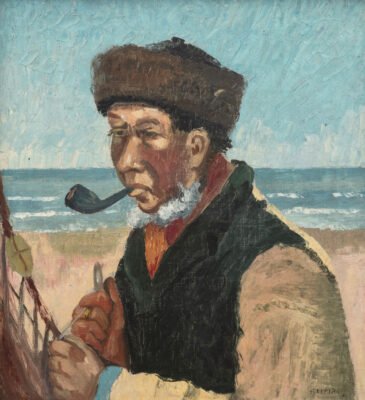For more than two decades, Isabella Ducrot, an artist who was born in Naples in 1931, has lived in an apartment on the top floor of the Palazzo Doria Pamphilj, in the center of Rome. When I knocked on her door for the first time, this past spring, she greeted me with an emphatic pronouncement in English: “I must tell you immediately that I have never been so happy in my life!”
It was a Tuesday evening in April, and I’d landed in Rome just a few hours earlier. Originally, Ducrot and I had arranged to meet for lunch the next day, but when she learned of my schedule she invited me to come over sooner, for a drink and a light dinner, noting in an e-mail that she “would be enchanted” to see me immediately. She opened the door to the apartment—where she lived with Vittorio (Vicky) Ducrot, her husband of fifty-eight years, until his death, in 2022—and I entered a spacious hallway densely hung with dark, dramatic Baroque paintings. Light shone on them from French doors that led to an expansive terrace. A side table held a vase of roses that were hovering on the edge between bloom and decay. Ducrot, who is tall and upright, grasped my hand more firmly than I would have expected, saying, “Please believe what I tell you. I adored my husband, and I am half a person now that he is not with me. But I am happy—happy.”
Only in the past five years has Ducrot, who turned ninety-three in June, become internationally recognized for her art, which she didn’t even begin making until she was in her fifties. When creating her works, she stands and uses a brush sometimes attached to a stick, sweeping loose arcs of ink or paint onto paper or fabric. She often later incorporates scraps of other papers or textiles. Her painted collages usually depict ecstatic figures and stylized landscapes; arrays of ovals or checkered patterns are a recurring feature. Typically made in series, her works are light, energetic, and uninhibitedly beautiful.
Ducrot’s œuvre has been admired in Italy for three decades: in 1993, a tapestry was included in the Venice Biennale, and in 2008 and 2014 she had solo shows at the National Gallery of Modern and Contemporary Art, in Rome. But it wasn’t until 2019 that she was championed in earnest outside the country, when Gisela Capitain, a gallerist in Cologne, Germany, mounted a solo show of Ducrot’s work which featured iterative images of flowers in vases, along with several pieces from a series, “Bella Terra,” each of them depicting a tree and a flowing river. It was as if Ducrot, in her ripe ebullience, had leapt directly into a late-Matisse phase—full of color and shorn of fuss.
This summer, the Consortium Museum, in Dijon, France, is hosting Ducrot’s first international solo museum show, heralding her, counterintuitively, as “a young artist with a young career.” The exhibition includes eleven paintings, on paper, from a series that Ducrot calls “Tendernesses”; they show two figures exuberantly entangled amid a patchwork of patterned blocks. Secured to the gallery walls with pins, the paintings—like the blissful people depicted within them—seem to float unsupported.
Since Ducrot’s husband died, she has shared her apartment with her housekeeper and two cats. Apart from a daily excursion to her studio, on the palazzo’s ground floor, she only occasionally leaves home—a sharp contrast to her earlier life, which was uncommonly adventurous. Vicky Ducrot was the prosperous founder of a luxury-travel company, Viaggi dell’Elefante, and the Ducrots journeyed extensively to India, China, Laos, Myanmar, and many other countries, taking with them paying groups of well-heeled and cultured visitors—most of whom already were, or eventually became, their friends—to see architectural sites and to shop in markets. On those trips, Isabella bargained for rare and fragile textiles from merchants in places such as Kashmir and Isfahan, amassing a singular collection. Her treasures range from seventeenth-century Tibetan prayer shawls to fragments of Egyptian cotton dating possibly to the ninth century. Vicky collected Indian miniature paintings, becoming a self-taught expert. On their travels in Yemen, Uzbekistan, and elsewhere, the Ducrots gathered cuttings of wild roses—transporting damp stems in their suitcases before planting them at their country house, in Umbria, where they tended a garden exclusively dedicated to the genus. It still supplies flowers for Isabella’s apartment.
Despite her late start, and even later recognition, Ducrot’s artistic flowering has been immensely productive. Andrea Viliani, the director of the Museo delle Civiltà, in Rome, which will exhibit a selection of Ducrot’s works alongside examples of historical textiles from its own collection this summer, told me Ducrot is fortunate that her preferred technique and materials remain relatively easy for her to manage, compared with, say, sculpting metal or painting with oils on heavy canvases. “Her work is easy to hold, and easy to paint, and easy to store,” Viliani said. “It is very convenient that she chose something so soft.” Sadie Coles, a gallerist in London who presented a solo show of Ducrot’s work last year, and is currently hosting another, first encountered the paintings in a booth at Art Basel, in 2022. She bought one of Ducrot’s landscapes without knowing anything about the life of the artist. “My initial response was just how fresh it was,” Coles told me. “I would never have guessed it was made by a then ninety-one-year-old! There’s a sense of play, of texture, of discovery.” Ducrot’s works, Coles added, “feel so full of sex, intimacy, and erotic charge.”
In an introduction to a catalogue about the “Tendernesses” series, the Italian scholar Emanuele Dattilo writes that people are frequently amazed to discover that the creator of such explicitly sensual works is “a lady who is well over the age of eighty.” Of course, this reaction reveals as much about the limitations of the observer’s imagination as it does about the voluptuous reaches of Ducrot’s. We tend to assign to the elderly—and especially to elderly women—the vague, and often diminishing, attribute of wisdom, thereby suggesting that their own creative, intellectual, or erotic evolution has come to an end, and that their sole remaining role is to give advice to others. Ducrot’s work and life offer an alternative possibility: that an individual might remain wide-eyed and open to experience—in an enduring state of naïveté, and with a capacity to be joyfully surprised—until the very end.
The Palazzo Doria Pamphilj, which was constructed over several centuries and occupies most of a block, remains the home of the aristocratic family for whom it is named. The clan’s most prominent member, Pope Innocent X, was immortalized by Velázquez in a celebrated portrait painted around 1650. This masterpiece is still on display at the palazzo, in one of several splendidly ornate rooms downstairs that show off the family’s art collection.
On our first evening together, Ducrot welcomed me into her apartment’s unfolding series of cozy, inviting rooms, which were filled with overstuffed sofas, Art Deco armchairs, and modernist tables by Alvar Aalto. Choice ceramics and glassware were arranged on mantels and tables. There was a yellow ceramic dish by Picasso; a white glazed Ecce Homo made by Ducrot’s son Giuseppe, a sculptor who specializes in religious iconography; and a medieval Islamic dish showing a rider on horseback, a gift from her other child, Enrico, who now runs the travel business. Art works by friends hung on the walls. There was a portrait of Ducrot, from about forty years ago, by Maro Gorky, the daughter of Arshile Gorky, and a 1977 pastel drawing of a lotus flower by Cy Twombly, who, along with his aristocratic wife, Tatiana Franchetti, often travelled with the Ducrots. (The Twombly is inscribed “For Isabela.”) There were also dozens more Baroque paintings, many dating to the seventeenth century and acquired in the nineteen-eighties and nineties, when such works were unfashionable. A shadowy, thorn-crowned Christ being taunted by a muscled thug, attributed to Annibale Carracci, hung in Vicky Ducrot’s still intact bedroom. The prize of the collection—a pallid, recumbent, half-naked Cleopatra, by Artemisia Gentileschi—was on loan to a museum, leaving a ghostly rectangle of space on a wall near the kitchen, where a litter box was discreetly positioned.
Ducrot asked her housekeeper, Shanthi Wijesundara, to pour us glasses of champagne, and we settled side by side on a sofa. She wore an oversized olive-green sweater, wide-legged black satin pants, and chunky pale-pink sneakers; her hair was white and cut in a blunt, chin-length bob with a center part, and around her neck she wore a gold chain with a pendant of green glass. She was chic and easy in her manner, but life at her age is far from effortless, she said. Since Vicky’s death, Ducrot has been increasingly dependent upon Wijesundara, who has worked for her for forty years. “She washes me,” Ducrot told me at one point. “I am completely in her hands.” As we sipped our champagne, Ducrot explained that the happiness she felt was not unqualified. “I am terrified also, naturally, because friends of mine, old people, are dying,” she said. “But happiness is another thing. I think I am helped by the words that come to me—words are more generous with me now.”







